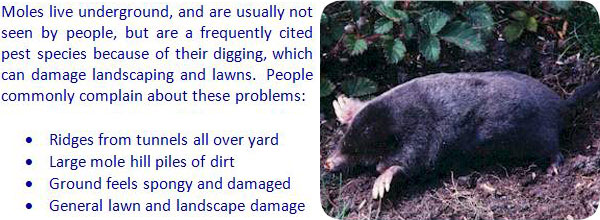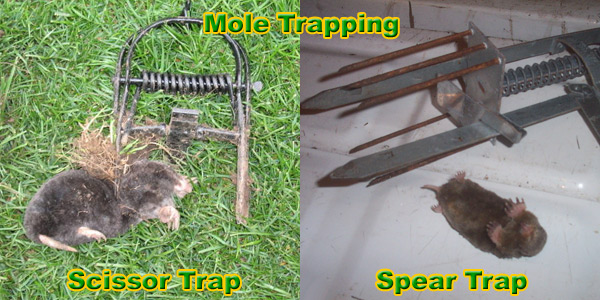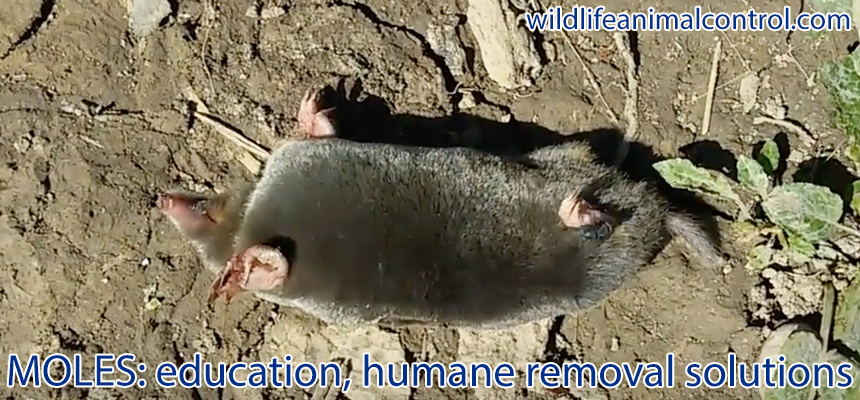- info@wildlifeanimalcontrol.com
Call us for help in your town
Wildlife Control Education
How to Get Rid of Moles in the Yard

We perform mole trapping in over 1700 USA locations - serving the whole USA.
It is my goal to educate the public about moles and other wildlife, and
provide tips for safe, effective, and responsible wildlife removal.
Summary of Step-By-Step Instructions:
1) Identify the primary mole tunnels - the travel routes, and not the one-time use feeder tunnels. These routes are often on straightaways, next to a building or sidewalk.
2) Squish down a few portions of tunnel and see if they get pushed back open.
3) Set mole traps on the primary tunnels. You can use scissor traps, harpoon traps, or even inside-tunnel traps.
4) Remove any trapped moles. They are territorial, so often the capture of only one or two will solve the problem.
Need mole removal in your hometown? We service over 500 USA locations! Click here to hire us in your town and check prices - updated for year 2020.
How to Get Rid of Moles - Moles are funny looking creatures that live underneath your lawn in tunnels that they dig. Moles spend almost their entire lives pursuing food and mates as they do not hibernate. In fact, moles barely have any fat on them at all which makes them powerful, but also requires them to eat almost their body weight in worms every single day. Moles have a dark brown coat, strong hind leg muscles and strange flesh colored paws and claws that are used to push through dirt and cut roots that lay in their path. Moles are solitary creatures and do not hurt humans or other animals, but even though they are docile enough, they can destroy your lawn.
Read more about mole biology here.

Moles are a gardener or farmers worst nightmare. The tunnels they dig can destroy any and all the plant roots that they come into contact with. They also leave large mounds of dirt anywhere they go which is not only an eye sore but can be an indication of a larger problem. Mounds mean that you have a large maze of tunnels right under the surface of your lawn that you did not even know was there. If you get enough of these tunnels, it can kill your gardens, crops and even collapse part of the ground. If you have noticed that you have tunnel openings or mounds of dirt, mole hills, that are littering your lawn, you will want to take these steps to get rid of your moles right away.
- Trapping a live mole will take some patience, but it is a humane way to get rid of them. Sit and watch your lawn to track the movement of a mole. Once you see it moving, take a shovel and block the entrance or one section of the tunnel. Now take another shovel and quickly block the direction the mole is going in. This will trap a live mole so that you can relocate it or have a professional come and take it. This will make it easier to kill if that is what you want to do.
- Another method of trapping a mole is just like you would trap a mouse. You can use a snap trap which is messy and not guaranteed to kill the mole or you can use a live trap that is set at the entrance of the tunnel. Bait these traps with salami, pepperoni or sausage to coax the mole back out of the tunnel.
- You can flood the tunnels with water by sticking a water hose into the hole or water the ground above the tunnel while gently stepping on it to close the tunnel. If regular water does not seem to be working you can try mixing your own solution of water, biodegradable dish soap, cayenne pepper and castor oil and pouring it in the tunnel. The pepper and castor oil will stick to the mole’s skin and make it immobile or try to dig away from the burning solution. However, this solution is completely safe and will not hurt them.
- To prevent moles from gaining access to your garden or to your yard. A thin wire mesh that is buried at least a foot and a half into the ground and sticks a few inches above the ground should do the trick. If you are worried about the moles chewing through the mesh, you can always buy a thicker or sturdier wire. This is an expensive option, especially if you decide to do the entire yard, instead of just the garden. This will also do nothing for the moles already in your yard, but it is a step in the right direction.

More in-detail how-to mole removal articles:
Information about mole trapping - analysis and methods for how to trap.
Information about how to kill a mole - with poison or other methods.
Information about how to keep moles away - prevention techniques.
Information about how to catch a mole - remove one stuck in the house.
Information about mole repellent - analysis of types and effectiveness.

Mole Information & Facts
Mole Appearance: The mole is very similar in appearance to the mouse, and many people mistake the two at first glance. Moles have longer bodies than mice and small or nearly indiscernible ears. Because they are subterranean dwellers, moles also have small eyes. Unlike the mouse, a mole’s tail is much shorter than the length of its body. The legs are similarly disproportionate appearing, made to be short and sturdy, their primary purpose to move large amounts of dirt. Much unlike small rodents, the mole has a second thumb on each hand. Moles can vary in color with the most common hues being gray, brown, and black.
Mole Habitat and Behavior: Moles prefer soil that is loose and well aerated, staying clear of soils with a heavy clay base. Loose soil is easier to tunnel in and provides proper air saturation and exchange within the tunnel system. Soil preference also includes areas with high moisture content. For these reasons, the mole has traditionally lived in forested areas where the first layer of soil is freshly decayed plant matter. With the constant encroachment of humanity into the wild, moles are just as much at home in well-kept lawns as they are in their natural habitat. A routinely mowed lawn will provide the mammal with more nutrients than a forested acre.
Moles develop a complex system of tunnels beneath the soil. The area considered living space is much deeper than then tunnels frequently visible just below the sod. Living tunnels will consist of linear tunnels usually around a deep root system of a shrub or tree. Deep tunnels are run by the mole frequently and are the major sources of food for the animal in colder weather. Insects burrowing into the soil to avoid the frost will end up in the deeper tunnels where the mole will consume them upon discovery. The shallower tunnels are almost always single use tunnels, created to hunt down the grubs and larvae that live in the upper part of the soil. These shallow runways can connect, though they are rarely used more than once. Dead ends are a common occurrence in this type of forage passage.
Bath male and female moles are territorial. The only time they interact is during the mating season. Breeding happens once within a year, and females will give birth to approximately three young. The male mole has no active part in the birthing process, and will leave the female immediately after fertilization. When the mole pups are six weeks of age, the mother will force them out of the tunnel. At this age, the young moles are capable of feeding themselves.

Mole Diet: Moles live most of their lives underground. Their diet consists mostly of earthworms, though they will eat larvae, grubs, slugs, and other small insects that burrow into the soil. Beetles make up a large portion of the mole diet in some areas. In order to keep its constant rate of energy up, a mole must eat its own body weight in food daily.
Mole Nuisance Concerns: Most people dislike the destruction moles can do to a landscaped yard. Shallow tunnels will leave the topsoil soft and prone to disruption by lawnmowers and other heavy objects. Extensive tunnel systems will often be characterized by large mounds of dirt throughout the property. This dirt will eventually kill and grass beneath the mound, resulting in large, brown areas in lawn. Despite some current beliefs, moles do not eat the bulbs of plants or vegetables.
Mole Diseases: Because the mole spends most of its solitary live underground, there are few important diseases associated with it. The most widely accepted zoonotic disease is leptospirosis, though this bacterial infection is very rare in the mole.
You're here to learn how to get rid of moles in the yard or lawn. This site is intended to provide mole education and information, so that you can make an informed decision
if you need to deal with a mole problem. This site provides many mole control articles and strategies, if
you wish to attempt to solve the problem yourself. If you are unable to do so, which is likely with many
cases of mole removal, please go to the home page and click the USA map, where I have wildlife removal experts
listed in over 500 cites and towns, who can properly help you with your nuisance mole.

















